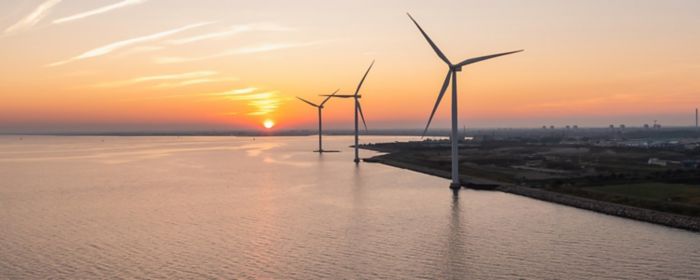Renewable energy embraces a range of sub-sectors, but the field is dominated by three: photovoltaic solar (which accounted for 47 percent of new global capacity added in 2016), wind power (34 percent) and hydropower (15.5 percent).1 But the future of all three depends on innovation in battery storage and energy aggregators, both of which are becoming increasingly important to investors.
According to respondents, the biggest sub-sector rise in M&A activity over the next 12 months will be in offshore wind (cited by 43 percent), followed by hydropower (39 percent) and photovoltaic solar (16 percent). Thermal solar and onshore wind are each mentioned by just 1 percent of respondents.
Key messages
- Offshore wind will see the biggest sub-sector rise in M&A over the next 12 months, according to 43 percent of respondents. Investors are paying close attention as operational and manufacturing costs come down, and wind farms in Europe and China produce increasingly impressive results.
- EMA is the region drawing the most attention from investors looking to offshore wind for new opportunities. The UK (53 percent) and Germany (28 percent), are the most attractive, with multiple projects already operational or in the pipeline.
- Hydropower is of interest to 39 percent of investors, despite hydropower already being well established in most regions.2 The bulk of this attention is focused on ASPAC and Latin America, where there remain pockets of untapped potential and plans for major projects.
- Battery storage, energy aggregators and hydrogen are considered major drivers — and challenges — to investors in the long run.
Offshore outlook by region
Among the countries that respondents see as attracting the most investment in each of the three sub-sectors mentioned above, 53 percent say the UK is the top choice for offshore wind, followed by Germany at 28 percent. Just 2 percent of respondents see the US as the most appealing target for offshore wind investments.
Various factors are contributing to its popularity in Europe. In the UK, for example, offshore project design and construction are appealing to investors, as the transmission cable and asset are built together, which is better for the overall quality of the project, according to Adrian Scholtz at KPMG in the UK; responsibility for the transmission line is with the transmission-system operator, not the owner of the generation asset.
In the US, meanwhile, the industry has been slow to take a foothold, despite its long stretches of suitable coastline. As of 2016, there was only one American offshore wind farm in operation, Block Island Wind Farm off the coast of Rhode Island. Other projects are at various planning, approval and financing stages - but many have been delayed or abandoned over the years due to politics and bureaucratic obstacles.

>> Enlarge infographic (PDF 183 KB)
Battery storage
Large, grid-scale battery systems are vital to the future of renewables because they make it possible to store surplus energy and create sustainable power supply from inconsistent and varied sources. Currently, the lack of efficient and effective electricity storage systems means wind turbines have to be turned off when demand drops, or when the grid becomes overloaded. Batteries would allow renewable energy projects to act more like conventional power stations, with the option to provide a constant output if required.
When considering an investment in future renewable energy projects, 98 percent of respondents say the inclusion of battery storage is important, including 57 percent who find it very important.
Regulatory and contractual considerations add to the complexity. Although the idea of hooking up a wind or solar farm to battery storage is sound in theory, the ability to store energy and sell it on may be subject to limitations imposed by energy offtake contracts, subsidy mechanisms and financing agreements.
Hydrogen
Like battery storage, hydrogen offers another way to make the most of electricity that might otherwise be wasted, through `power-to-gas' technology. The key is electrolysis, the process by which water molecules are split into hydrogen and oxygen using electricity. Converting electricity to hydrogen (or, in an additional step, to methane), means the gas can be used as a substitute for natural gas or other fossil fuels. Hydrogen has an extremely high energy density, emits no CO2 when burned and, unlike electricity, can be stored indefinitely.
Nearly three-quarters of respondents (74 percent) believe hydrogen will be a significant enabler for the advancement of renewable energy.
Annette Schmitt at KPMG in Germany argues that governments need to pay more attention to hydrogen's potential: “The trend is towards electrification of the heating and transport sectors, but the storage of excess electricity through methane in the existing gas grid is largely overlooked in policy making.”
Renewable energy aggregators
Renewable energy aggregators have emerged in response to the increasing fragmentation of power generation, particularly in California, where regulators have been trying to open up the power sector to give consumers
greater choice.3
While still very new, aggregators provide centralized management of supply and demand. This is achieved by coordinating power generation (from sources such as wind farms and solar installations), consumption (commercial and domestic) and storage (such as batteries). Demand and supply are monitored and dispatched by the aggregator, so the grid is kept in balance.
Overall, 91 percent of respondents say renewable energy aggregators will be important in facilitating investment in renewable energy projects, with just over half (52 percent) saying they will be very important. Nearly three-quarters (73 percent) of respondents say renewable energy aggregators will be a significant part of the market in the next 3 to 6 years.
Another area of technology that respondents believe will impact the renewable energy market is smart grids, which use real-time digital communications to coordinate supply and demand. As we shift from centralized power plants to decentralized generation, existing grids will struggle with the number of feed-ins. Trying to integrate renewable sources at medium- and low-voltage levels with inconsistent output will add to the complications.
Smart grids will provide consistent and secure supply, allowing energy providers to improve performance and to oversee operations while getting the most from their assets, attracting investment from electricity companies and
investors alike.
Sources:
1 - “2016 Was Another Record Year for Renewable Energy”. The United Nations Framework Convention on Climate Change (UNFCCC). 7 June 2017.
2 Renewables 2017: Solar leads the charge in another record year for renewables.” IEA. 4 October 2017.
3 - “As California Mulls Retail Electricity Choice, Utilities Are Losing Customers in Droves”. GTM. 17 May 2017.
Download the key messages infographic>> (PDF 160 KB)
Download the full report>> (PDF 3.4 MB)
Connect with us
- Find office locations kpmg.findOfficeLocations
- kpmg.emailUs
- Social media @ KPMG kpmg.socialMedia


